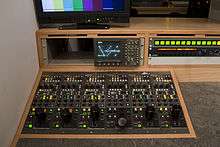Camera control unit

The camera control unit (CCU) is typically part of a live television broadcast chain. It is responsible for powering the professional video camera, handling signals sent over the camera cable to and from the camera, and can be used to control various camera parameters remotely.
Use in historical productions
Before cameras became self contained units broadcast quality cameras required vast racks of control units just to generate a usable picture. In outside broadcast production, these racks took up an entire section of the OB truck and were operated by a small team of skilled engineers. These vision engineers had two roles. Firstly, they setup the CCUs at the start of a production and ensured that the picture created was of broadcast quality. This process included a lengthy 'lining up' process in which the vision engineer would work with the camera operator, to adjust the settings on both the actual camera and the CCU in tandem. During production, it was the vision engineers job to operate the CCUs and control both the focus and the colour balance. So skilled and labour intensive was this role that each CCU required its own dedicated vision engineer.[1]
Advantages over using independent cameras with automatic settings
Modern cameras are more self-contained than their predecessors and most can operate without a CCU. Even when not required, a CCU can be of benefit for the following reasons.
- In a system with multiple-camera setup, the cameras can be matched – made to look the same in terms of colour balance and picture intensity without having to ask the camera operators to make the adjustment.
- The camera operators are freed from the control of iris and black level, leaving them free to concentrate on other aspects of camerawork such as blocking and image composition
- All signals that operate between the camera and CCU are carried in one multicore cable, triax or fiber optic cable.
Scope of CCU functions

A CCU is often used in conjunction with a remote control panel (RCP), a waveform monitor and a vectorscope to rack and match many cameras together remotely.
Common adjustable parameters include:
- Iris (see aperture)
- Color temperature filters
- Neutral density filter
- Master black (pedestal)
- Black level trim (for red, green and blue components)
- Gain trim (for red, green and blue components)
- Master gain
In addition to these, there are usually options internally generating a test card for testing, return feeds or talkback. For more complex production, preset scene files can be recalled to quickly change the settings of the camera on the fly.
Connections to a CCU
Broadcast cameras typically carry several signals over the camera cable in addition to the camera output itself.
Typically, RGB signals are transmitted over the camera cable. The CCU will usually convert these to SDI, YUV or composite for interfacing to other video equipment.
Typical signals can be both digital signal and analog signals:
- Video out (Serial digital interface (SDI)
- Video out (composite video)
- Video out (component video)
- Audio out (microphone on board)
- Video in (genlock in the form of color burst)
- Return video in (composite)
- Return video in
- Interruptible feedback Intercom
- Tally light trigger
See also
References
- ↑ John, Ellis,; Nick, Hall, (2017-11-09). "ADAPT". figshare. doi:10.17637/rh.c.3925603.v1.